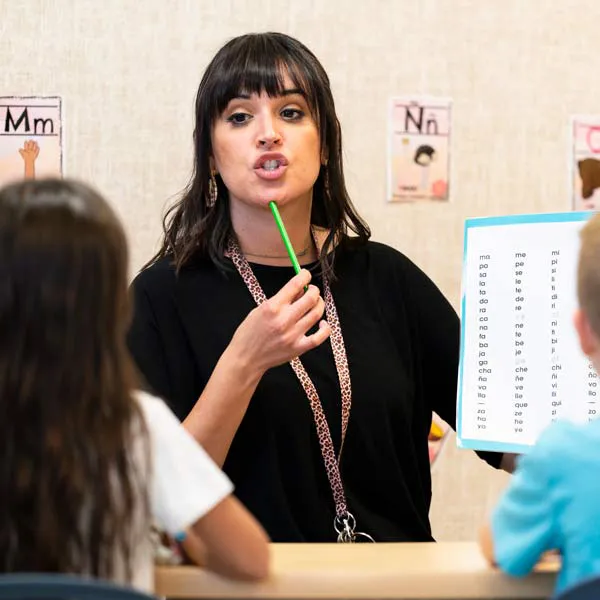What Is an ESL Teacher?

An English as a Second Language (ESL) teacher is a teacher that provides direct support to multilingual learners, specifically English language learners (ELLs), usually in the form of explicit English language instruction.
This can take multiple forms depending on a district’s model of service, including in-class support during content instruction, pull-out instruction (or a separate period specific for English instruction at the secondary level), or coaching and other forms of support for the teachers of English learners (ELs).
An ESL teacher works with any student who is eligible to receive services, usually because the student knows a language other than English. This includes both students who:
- First learned a different language growing up and then began to learn English at school, or
- Simultaneously learned both languages from birth or early childhood
ESL teachers are also called ESOL teachers (English for Speakers of Other Languages) or ELD teachers (English Language Development). These terms can be used interchangeably.
Rewards of Being an ESL Teacher
There are a vast number of benefits to working as an ESL teacher, including:
- Deeply impacting the lives of students and their families
- Serving as a bridge between language and content for students
- Celebrating and affirming the linguistic and cultural assets of all students, but especially multilingual learners
ESL teachers are generally compensated at the same rate as any other teacher on the district’s teaching contract.
ESL Teacher Responsibilities
A day in the life of an ESL teacher is always filled with language! In addition to teaching English and/or supporting English literacy development, they might have various other responsibilities, including but not limited to:
- Working individually or in small groups with English learners
- Documenting the progress of English learners
- Advocating for specific needs of English learners
- Providing specific feedback on the use of language forms or other academic language demands in the classroom
- Providing professional development to classroom teacher colleagues
- Planning events for culturally or linguistically diverse students and their families
ESL Teachers Don’t Have to Be Bilingual
A common misconception about ESL teachers is that they must be bilingual; however, since ESL teachers support the development of the English language, they do need to be fluent English speakers!
Both bilingual and monolingual teachers can make strong ESL teacher candidates by:
- Considering the unique needs of culturally and linguistically diverse students
- Providing language supports based on the language demands of a particular unit
- Using engaging strategies that provide scaffolding and authentic opportunities to use English in meaningful ways
There are an infinite number of ways to adapt instruction to support English learners, depending on their needs and the model used by a district.
Are ESL Teachers in Demand?
According to the Oregon Department of Education, nearly 100,000 students in Oregon were current or former English learners as of June 2023. That’s almost 18% of K-12 students! There is a strong need across Oregon and around the world for teachers who are passionate about culture, language, diversity and the English language.
So Many Acronyms: ESOL, TESOL, TEFL, TESL
All of the following are certifications that prepare candidates to work with multilingual learners who are also learning English. Each type of certification allows a candidate to teach English with a slightly different emphasis.
- ESOL (English for Speakers of Other Languages) - Standard certification for becoming an ESL teacher in the U.S. (read more below)
- TESOL (Teaching English to Speakers of Other Languages) - An overarching certification for teaching English to students in a different country, no matter the heritage language of the country where they are teaching
- TEFL (Teaching English as a Foreign Language) - Certification for teaching English in a country where English is not spoken
- TESL (Teaching English as a Second Language) - Certification for teaching English to those who have a heritage language other than English, but English is the generally accepted language of the country
If you’re interested in teaching English outside of the United States, learn more about TESOL, TEFL and TESL at goabroad.com.
How to Become an ESL Teacher in Oregon
Generally, becoming an ESL teacher in the U.S. means earning an ESOL endorsement, which is added to an existing teaching license. The endorsement requires additional training beyond a preliminary teaching license, usually made up of about five theoretical courses. The content of these courses ranges from understanding how to plan and prepare for ESOL and bilingual environments to applied English linguistics.
Additionally, Oregon requires a practicum with English language learner students and a passing score on the ORELA ESOL exam.
Some common pathways to earning an ESOL endorsement include:
- Adding the endorsement to an existing teaching license by completing additional coursework after a bachelor’s degree
- Earning an ESOL endorsement as a part of the initial teacher licensure with a degree in education (Master of Arts in Teaching Plus ESOL)
- As a part of a masters or doctoral program
At George Fox University, any of these options are possibilities!